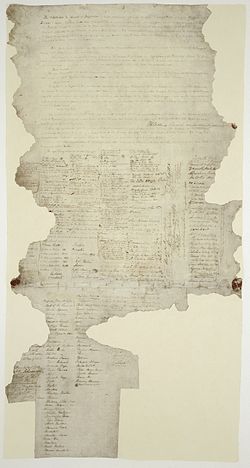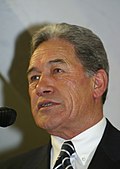Treaty of Waitangi
The Treaty of Waitangi, Māori: [te Tiriti o Waitangi] Error: {{Lang}}: text has italic markup (help), was a treaty that was signed on 6 February 1840 at Waitangi, New Zealand. It was signed by European settlers and by Māori chiefs. It is widely considered to be a founding document of New Zealand.[1] The Treaty of Waitangi marked the start of the official domination of New Zealand by Great Britain.[2] The legal status and modern relevance of the treaty has been at a disagreement for a long time. [2] The day on which the Treaty of Waitangi was signed, 6 February, is the National Day of New Zealand.[3]
Treaty Of Waitangi Media
James Busby, British Resident in New Zealand. He drafted a document known as the Declaration of the Independence of New Zealand.
Captain William Hobson
Rev Henry Williams, who translated the treaty into Māori with the help of his son Edward Marsh Williams.
A later reconstruction in a painting by Marcus King, depicting Tāmati Wāka Nene in the act of signing. Hobson is incorrectly shown in full uniform (he was actually wearing civilian clothing).[4]
Winston Peters (founder of the New Zealand First Party), who has campaigned for the removal of references to the Treaty of Waitangi from New Zealand Law
Related pages
References
- ↑ The Democracy Sourcebook, eds. Robert Alan Dahl; Ian Shapiro; José Antônio Cheibub, (Cambridge, MA: MIT Press, 2003), p. 242, n. 70
- ↑ 2.0 2.1 A. H. Angelo, Constitutional Law in New Zealand (Alphen aan den Rijn, The Netherlands: Kluwer Law International; Frederick, MD: Aspen Publishers, 2011.), p. 16
- ↑ "Waitangi Day". Ministry for Culture and Heritage. 5 August 2014. Retrieved 17 December 2014.
- ↑ King 2003, p. 163.
Other websites
| Wikimedia Commons has media related to Lua error in Module:Commons_link at line 62: attempt to index field 'wikibase' (a nil value).. |








